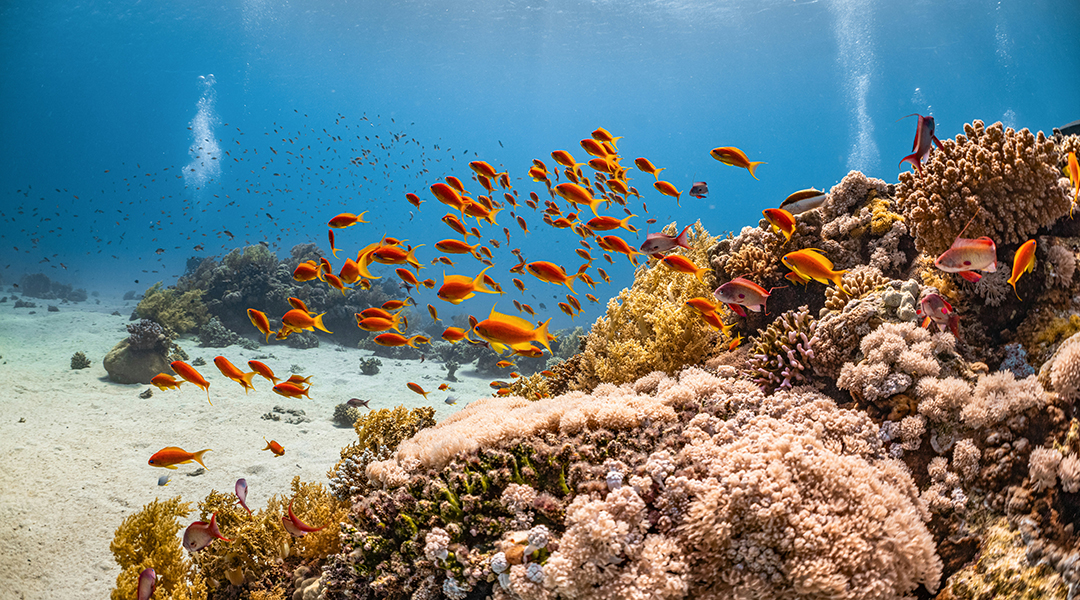Warming oceans driven by greenhouse gases are causing coral bleaching around the world in which healthy, vibrant reefs transform into lifeless coral graveyards with devastating effects on marine life.
“At a global scale, reducing greenhouse gas emissions is the only meaningful way to ensure a future for coral reefs but actions can be taken at local scales to improve reef health and resilience,” explained April Burt, research associate at the University of Oxford, marine management consultant with the Seychelles Islands Foundation and lead-author of this study researching how coral reefs connect to improve conservation efforts.
Since 1950, over half of the world’s corals have been lost, igniting a race against time to save these vital organisms. Efforts on local scales, such as restoring and reseeding coral populations are underway.
However, as coral larvae typically disperse in ocean currents before settling down and adding to or growing into new colonies, reseeding endeavors require a deep understanding of the flow of larvae between coral reefs — a concept known as connectivity.
Finding coral larvae sources
A collaborative team of scientists and conservationists participated in a study conducted in the Seychelles, an archipelago located in the Indian ocean off the East African coast.
Noam Vogt-Vincent, a researcher at the University of Oxford who led the ocean modelling for the study explains this was an ambitious undertaking and first-of-its-kind study for which the team collaborated together over many years.
During this time, they developed pioneering new methods for gathering data from an area over a million square kilometers in size to create an extensive roadmap illustrating how larvae disperse in the region in order to aid in future conservation efforts.
“Understanding and quantifying these connections is really important for conservation because it allows us to identify reefs to priorities for conservation efforts by targeting reefs acting as regional larval sources,” explained Vogt‑Vincent. “[This] improves our ability to make future predictions about how climate change and other stressors, such as pollution, might affect coral reef ecosystems.”
Mapping gene flow
Coral reefs are present throughout the Seychelles archipelago, which is comprised of the Inner Islands to the north and to the south-west, a group of islands known as the Amirantes, as well as the Outer Islands, which encompass several atolls including a UNESCO world heritage site.
With the outer islands least affected by bleaching, it was hoped that detailed mapping of the area would reveal larval sources to aid restoration efforts for other reefs in the archipelago.
The team chose a combined approach of genetic studies and ocean current modelling — two methods typically used in isolation, and each with their own pros and cons. Genetic studies, a gold standard, provide a direct measure of genetic similarity between reefs, while ocean current modelling simulates the flow of larvae between reefs, which can then be used to predict genetic similarity.
Vogt‑Vincent explained that a computer simulation similar to those used in weather forecasting was used to predict ocean currents. “Once we predicted the ocean currents, we then generated billions of virtual coral larvae, put them in our virtual ocean, and use the computer to predict where they are transported,” he said.
Through this modelling, Vogt‑Vincent stated they were able to identify groups of reefs that tend to consistently exchange larvae with one another and are presumably closely genetically related. They then compared this prediction to genetic studies the team simultaneously carried out in the region to see how closely the methods aligned.
It was the first time this combined approach had been used in this part of the ocean. “This study, combining genetics with ocean current modelling […] reveals the power of interdisciplinary science. Each of these studies is revealing, but together, they paint a much more telling picture,” remarked Lindsay Turnbull, professor of plant ecology at the University of Oxford, and senior author of this study.
Describing the strengths and weaknesses, Vogt‑Vincent explained, “The ocean model used in our study is by far the highest resolution that has been run for such a large area in the Indian Ocean, which allows us to simulate larval dispersal around fairly small islands. However, the resolution is still too coarse to fully resolve these coastal currents, so it is likely that our simulations overestimate the physical connectivity between coral islands.”
Although ocean modelling can underestimate the complexity of factors affecting larvae dispersal, including physical and biological processes, it is a cheaper and quicker way to estimate coral connectivity.
Coral reef conservation
Both methods indicated strong connections between coral reefs located around the Seychelles archipelago, meaning ocean currents are in fact helping reefs in the area exchange larvae. The broad agreement between the two methods supports the use of modelling, a less labour-intensive option to complement the gold standard in predicting larvae dispersal.
Mitigating the effects of climate change is the only definitive way to fully protect coral reefs, but the team agree that local conservation efforts such as these also have a part to play.
“The utility of our research is effectively damage limitation and making the most of limited resources,” said Vogt-Vincent. “If we can identify well-connected reefs that have the potential to reseed damaged reefs to support their recovery, we can prioritise conservation efforts around these ‘source’ reefs. Whether this actually works is another question – this has yet to be robustly tested in the real world.”
While the current study focused on coral reef restoration and management, the lessons learned go beyond these efforts and may have other marine conservation applications.
“The methods we developed to compare simulations to genetic data can be used anywhere, and for other marine species, not just corals,” added Vogt-Vincent. “Our simulations also predict coral reef connectivity for the entire tropical southwest Indian Ocean, not just Seychelles.”
Reference: Burt, A J, et al., Integration of population genetics with oceanographic models reveals strong connectivity among coral reefs across Seychelles, Scientific Reports (2024). DOI: 10.1038/s41598-024-55459-x
Feature image credit: NEOM on Unspladh

















